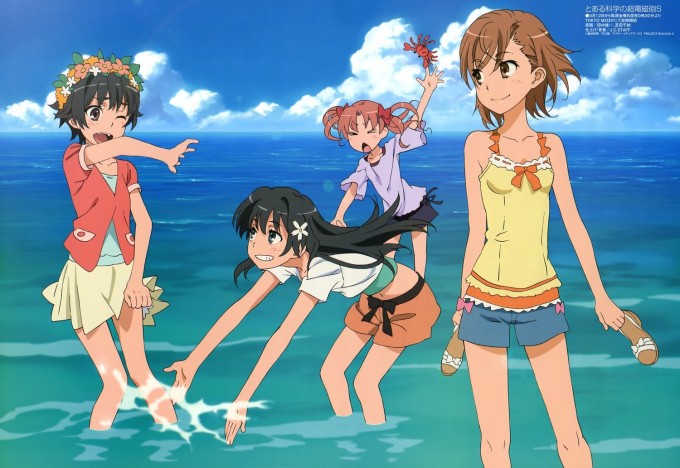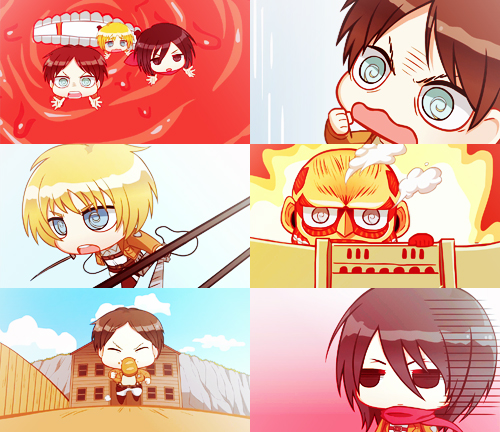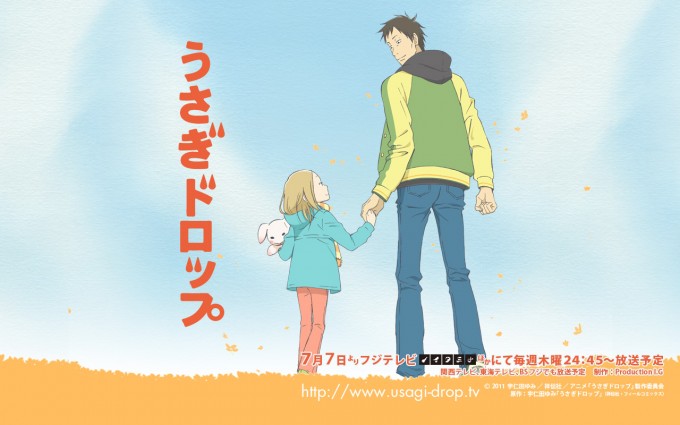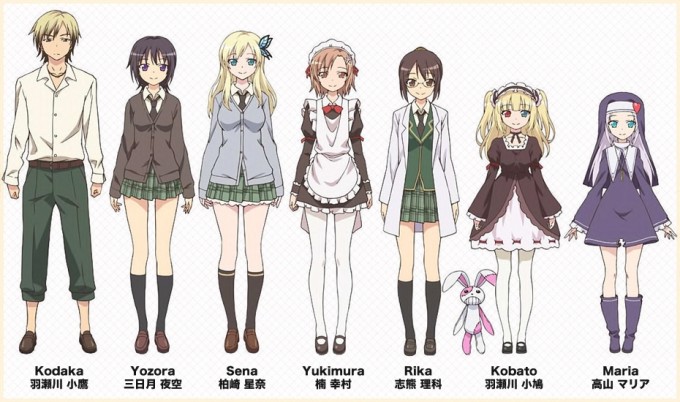September 10th, 2013 in Anime, General Reviews by The Droid

On the surface, this show, “Michiko e Hatchin” is just another ‘journey’ show, not much different than “Noir” or “El Cazador”, although potentially allied closer to “Samurai Champloo”, as least in attitude.
The tale takes place in ‘Alternative Brazil’; although it is never named, there is enough to imply that we are in South America. Michiko Malandro (that rather bounteous babe astride the scooter) is a felon, having run with Monstro Preto, a rather notorious gang, and has spent the last eight or so years in prison. Michiko is tormented endlessly, both physically and emotionally, by Atsuko Jackson, the police officer who arrested her. Here’s the odd thing: they grew up in the same orphanage, but obviously took different paths. By her telling Michiko that her daughter, Hana, is living with a foster family, Michiko breaks out of an ‘escape-proof’ prison to rescue Hana.
Hana (yes, that boy is really a girl; it’s just the presentation) is in a Cinderella-like situation, in that her foster family is those pretentious and insufferable religious types that we like making fun of. Dad is a priest who uses the position to feather his own nest, mom is a social climber and the kids are bratty beyond belief. Michiko steals the scooter, busts into the house, rescues Hana (whom she now calls Hatchin) and thus their journey begins to find dad, who Michiko knows is not dead, despite reports to the contrary. (more…)
Tags: Action, Adventure
September 8th, 2013 in Anime, General Reviews by The Droid

The other half of the brother-and-sister series is this one, “A Certain Scientific Railgun”. We are still in Academy City, where people who want to get the best education (and have esper powers) go to. Our missy to the right, Mikoto Misaka, is a Level 5 Esper, of which there are only seven in the entire city, and, of this septet, is the most powerful, or at least, the most feared. She can conduct electricity and what she does is flip a 100-yen coin into the air. When it comes back down and it about to pass the ecliptic, she uses it to shoot her electric bolt out and cause some serious damage.
She attends Tokiwadai High School (an elite among elites) and people have heard of her. Her roommate Kuroki Shirai (the purple one in back) has a SERIOUS fetish for Mikoto and is constantly looking for ways or opportunities to be physically intimate with her (which never works; this is a big running gag) . She also works for Judgment, a public service group that maintains peace and order in the City. She is a Level 4 Telekineticist and uses nails to pin her perpetrators to the wall, as well as teleport in and out of situations.
Kazari Uiharu (flower headband, far left) attends Sakugawa Middle School, a rather ‘normal’ school. She works in Judgment with Shirai, but more as logistics. She is a Level 1 Heater, having the ability to keep things warm at a constant temperature. Our last lady is Ruiko Saten, who attends school with Uiharu. She is a Level 0, but annoys the stuffing out of Uiharu, as she will flip up her skirt to see her underwear and comment about the pattern of the day. (more…)
Tags: Action, Fantasy, Sci-Fi, Super Power
September 3rd, 2013 in Anime, General Reviews by The Droid

This is half of what could be best called a brother-and-sister series. They are related in the fact they occur in the same town (Academy City) at about the same time and the characters do cross over and slightly interact, but that’s about it. They are independent of each other in what they wish to accomplish.
This one is “A Certain Magical Index”. Now, Academy City, a technologically advanced academic city located towards western Tokyo, which studies scientifically advanced superhuman students with powers, is also set in a world where magic is real. Our hero up there is Tōma Kamijō, a fairly average student but a flop when it comes to esper talents and abilities. In this town, your esper abilities determine much in your life and he is at the bottom, possessed with the worst luck ever.
The only thing he has going for him is his right hand, which he calls the Imagine Breaker, which has the amazing ability to negate magical and psychic powers. But since it is only considered an ability, he gets a Psychic Level of…..zero. He might as well be selling hot dogs from a street vendor wagon. (more…)
Tags: Action, Magic, Sci-Fi, Super Power
August 28th, 2013 in Anime, General Reviews by The Droid

This is more along the lines of an advisory, but if you haven’t seen “Attack on Titan” yet, there is something you should be aware of.
Now, the show has not really reached a conclusion of sorts. Sure, we’ve passed the 13-episode mark, but it is far from even a coupler point, so a full review will be done at a later point (and don’t worry, there will be a review for this show).
I have been catching this on Anime Season, a pretty decent website, but they have a couple of ‘specials’ that I want to warn you about, and the bottom line is: don’t watch them yet. I will explain.
Specials differ, in my opinion, from OVAs, as they have a real bearing on the show, whereas OVAs are either tales that were too hot to put in (like for “Ikki Tousen” and “Ladies vs. Butlers”) or a tale told long after the series closed out (like Mahoromatic’s “I’m Back”). “Girls Und Panzer” has both of them and they use the specials as recap shows or a meet-and-greet for those just coming to the show and want to know if they should watch.
(more…)
August 26th, 2013 in Anime, General Reviews by The Droid

I usually do not do reviews of shows that have been out there for a while. I am either going to merely join the praising chorus and agree with reviews that have gone before me of how fabulous of a show it is, or I will be a maverick and strike out into territory where I decry the wretched nature of this show and condemn anyone who has the temerity to like it.
Now, this is the kind of show I detest, as it has….wait for it….giant fighting robots! And the first two season of “Full Metal Panic” presents itself as hard, harsh drama as our combat hero, Sousake, has to struggle with balky machinery and his mental limitations to be able to remain in his mercenary force.
I am here to discuss the third season, “FUMOFFU”. Now, this violates every law of anime, in that you have completely changed the pitch and tone of the show, until the only thing it has in common with the previous seasons are the characters. Yet, this works and is the most consistently hilarious, off-center romantic comedy out there. Well, maybe not a real romance.
OK, let’s bring the rest of the people up to speed. (more…)
Tags: Action, Comedy, School
August 24th, 2013 in Anime, General Reviews by The Droid

It is hard to believe that this show is already at the two-year mark with little sign of slowing down. Nor has it encountered the malaise that sometimes beset long-format shows.
Now, we have the Main Story. This is Toriko’s special training, as he is eventually going to search for GOD (no, not the guy with the beard, but the ne plus ultra ingredient that is the cat’s meow). So, he does all this strenuous training that exercises both body and mind and promotes teamwork. And Torkio’s boss, Ichiryū (who looks like a reject from the Village People) has also managed to coerce the other Heavenly Kings (you see two others up there) to also do this specialized training. There is something more going on here than just being able to go into the Lost Forest, so one had best be prepared for it.
Then, there is a sub story that all the great chefs in the world are being kidnapped. For some odd reason, Komatsu (the REALLY wimpy one up there) has not yet cracked the Chef World Top 100 list. Odd; you would think the chef who brought back Century Soup would merit something, as EVERYONE comments about it, but it’s just not good enough and since he also works for a mere Six-Star restaurant, I might as well eat something at Barney’s Beanery. (more…)
Tags: Action, Adventure, Comedy, Fantasy, Shounen
August 19th, 2013 in Anime, General Reviews by Julie

When an outsider, aka those “normal” people who don’t watch anime because they’re “too old for cartoons”, thinks of anime a few things come to mind. Things like well-endowed women, giant robots, and obnoxious teenage boy protagonists. And, well, they’re probably right to an extent. Those of us who are well adapted into the anime world know that there’s much more to it. Yet, it seems that no matter what we’re looking at, be it anime, movies, television, or video games, we are obsessed with grouping everything into categories. For video games we have fighting games, RPGs, puzzles. For movies or television there’s action, fantasy, comedy, etc. Within those groups, we have tropes that are associated with them. The wise old wizard belongs to fantasy, the funny roommate who’s kind of a womanizer belongs to comedy. With anime this need to categorize is certainly evident, but I have found that Usagi Drop is in a category of its own.
If you’ve seen this short but loveable series, try to think of one trope that it really fits into. The main character is a bachelor, but he’s not a skirt chaser, or the chosen hero. He’s just a typical thirty – something man. Usagi Drop is considered a slice of life anime, but the setting isn’t a school filled with peppy teenagers. It also can fall into the very rare josei genre, but doesn’t focus on romantic relationships like they so often do. I would argue that Usagi Drop would fall into the “other” genre if there was one in anime. This is what makes the show so special. It doesn’t have any of the clichés that anime are always associated with. It’s a breath of fresh air, really. (more…)
Tags: Josei, Slice of Life
August 13th, 2013 in Anime, General Reviews by The Droid

Crime has never been so odd and criminals never so odder. “Cuticle Detective Inaba” initially follows the standard crime drama trope. Our hero, Hiroshi Inaba (dead center), used to work for the police department, but got tired of being bossed around and thwarted in what he could accomplish, so he struck out on his own, as he feels he can do more without the restraints of police protocols and his annoying partner. And that’s where the standardness ends.
You have noticed the ears, right? Well, that isn’t some rockin’ hair style, our detective is a genetically-engineered werewolf and he can determine EVERYTHING about a person by tasting their hair. OK, it’s not as bad as licking drool, but still….
He will need all of his skills as a new villain has come to Tokyo, Don Valentino, a Mafia crime boss who is going to bring Japan to her knees with a daring series of bank robberies. He will amass all the money in the land…..so he can eat it. Yes, that guy IS a goat. Aiding Don is his fight is Fernando, that burlap-bagged guy who looks like a refugee from “Resident Evil”, Dr. Noah (the purple-pigtails. Yes, Woody Allen did that joke in 1967 with “Casino Royale”) and Gabriella, that scowling maiden at the far left, who is simultaneously the best and worst assassin ever. Oh, she can hit her mark….but it’s usually Don. Right between the eyes. (more…)
Tags: Action, Comedy, Mystery, Shounen
August 11th, 2013 in Anime, General Reviews by The Droid

OK, Season Two is upon us for “The Neighbor’s Club” (or, the new title “Boku wa Tomodachi ga Sukunai NEXT), where we build on the good will and storytelling of the first season to expand up our little entourage and see them grow and mature into the adults of the future. Sorta.
Part of the problem with a second season is if you do not have a clear picture of what you want to accomplish, you are just retreading, or following the same path or sticking with that which worked, rather than expanding outwards. And this is exactly what happens. It is as if they got to a point they feel good with and left it at that. The only one who is trying to move forward (of sorts), is Rika, the mad scientist, who goes through a transformation to be something else, so she looks really different.
We still have the verbal fisticuffs between Yozora and Sena, as well as the battles between Kobato and Maria, but Kodaka is still just as clueless on things, even when aspects of his past are brought forth. The injection of conflict into this show seems kind of artificial. I am also amazed as to what people remember from their youth. I have foggy notions and nothing truly concrete, but these folks recall it like it was earlier in the day. (more…)
Tags: Comedy, Harem, Romance, School, Seinen
August 4th, 2013 in Anime, General Reviews by The Droid

I just am not certain what gives with all the ‘nothing’ shows. Sometimes it works, as with “Joshiraku”, but a lot of the time for a lot of the shows, it is a head-scratcher. You are not even certain if you like or dislike the show, as there really is nothing there to grab ahold of to determine whether you like it or dislike it. It reminds me of going to Denny’s: I can get something to eat, but it has no lasting impact on me. Did I even really have food? “Minami-ke Tadaima” is that kind of show, as we watch these three sisters who live on their own and the problems they face in everyday life, with their friends at school and at home.
The three sisters are, left to right, Kana the headstrong, Chiaki the youngest and Haruka, who is the eldest. There is no explanation as to why they are on their own, but Japan seems to have more absent and/or dead parents than even in the Disney Universe. They are getting along and trying to understand what life is about and what growing up entails. At least, that is what you are hoping for. (more…)









